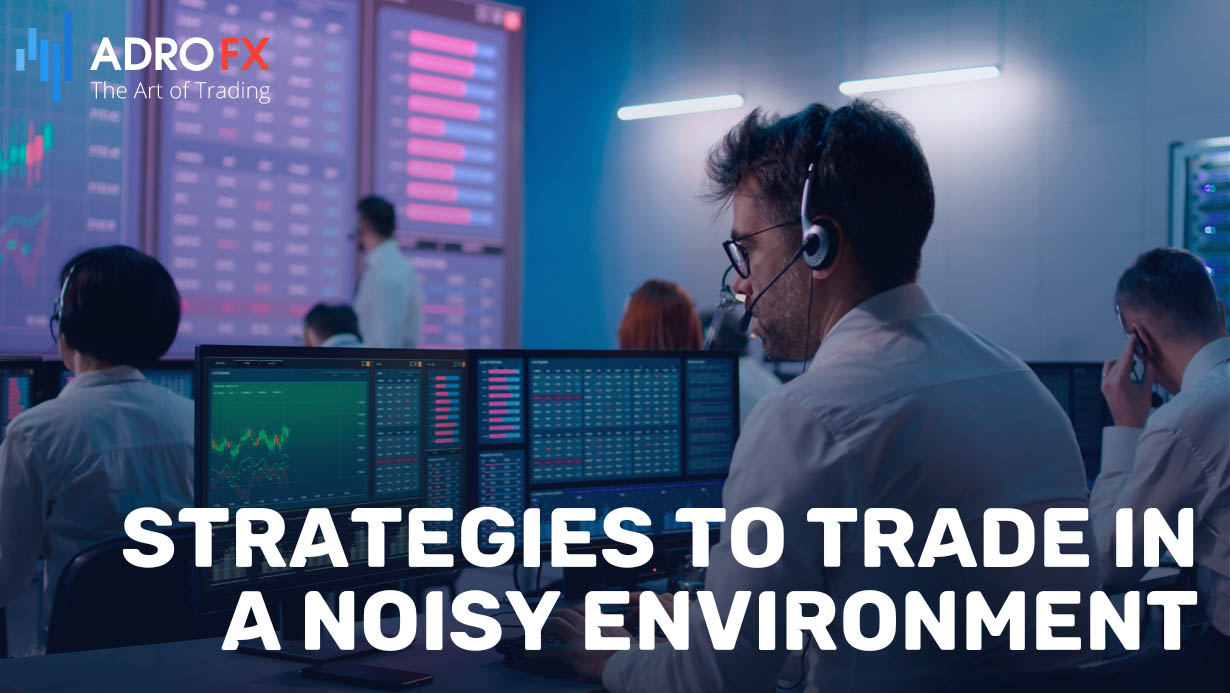Breaking Down Market Noise and How to Avoid It

In the breakneck world of finance, market noise is an ever-present challenge for traders and investors. The constant flow of information, data, and news can obscure the underlying trends and fundamentals that drive the financial markets. It's akin to navigating a bustling marketplace, where every vendor vies for your attention, offering their wares in the form of information. In this article, we delve into the concept of market noise, exploring its definition and the impact it has on trading and investing. We'll also provide strategies to identify, filter, and ultimately navigate the noisy landscape of financial markets, equipping you with the tools to make informed decisions amidst the cacophony.
Understanding Market Noise
In the world of finance and investing, the term "market noise" refers to the constant stream of information, news, and data that inundates the financial markets on a daily basis. This deluge of information includes everything from economic reports and corporate earnings releases to geopolitical events, social media chatter, and even rumors. Market noise is essentially the cacophony of information that surrounds and influences the financial landscape.
Market noise can be compared to a bustling marketplace where vendors are selling various wares, all vying for your attention. In this case, the wares are pieces of information, and they come from a multitude of sources, including news outlets, financial analysts, social media, and even individual investors.
Moreover, the rise of algorithmic trading and high-frequency trading has added another layer to market noise. These automated trading systems react to information and execute trades at incredible speeds, sometimes amplifying the impact of market noise.
In essence, market noise is an inherent part of the financial landscape, and individuals involved in trading or investing must learn to distinguish between what matters and what is merely a distraction. This skill is vital for making sound financial decisions in an environment where the line between information and noise is often blurred.

How to Spot Market Noise
In the intricate world of finance, the ability to discern between valuable market information and mere market noise is a crucial skill for traders and investors. Spotting market noise involves sifting through the constant barrage of data and separating meaningful signals from distracting chatter.
One key strategy in spotting market noise is to know your sources. Establish a strong familiarity with reliable and reputable sources of financial information. Traditional news outlets, official government reports, and corporate earnings releases often provide accurate and trustworthy information. They act as anchors in the sea of data, offering reliable sources to guide your decisions.
Fundamentals are another cornerstone in your quest to identify market noise. Pay close attention to the fundamental factors that underpin market movements. Earnings reports, economic indicators, and the performance of individual companies often wield more influence on asset prices than the fleeting buzz generated by momentary news events. By focusing on these fundamentals, you can distinguish between lasting trends and short-lived noise.
Understanding the market's reaction is also crucial. A genuine development in the financial world tends to provoke significant price movements and a surge in trading volume. If a piece of information is truly impactful, the market will respond accordingly. Conversely, if the market remains relatively steady in the face of news, it might be an indication that the information lacks substance and is merely noise.
Verification is an essential step in this process. Before acting on any piece of information, especially if it seems extraordinary, take the time to cross-reference it across multiple sources. Relying on a single, unverified source can lead to hasty and potentially costly decisions. Rumors and unverified news can spread rapidly, so it's crucial to maintain a healthy dose of skepticism.
Context is a key factor in the quest to spot market noise. Consider the broader picture and the context in which the information is presented. Some news events may be isolated incidents with limited market impact, while others could have far-reaching consequences. Understanding this context will help you prioritize information that truly matters.
As you navigate the labyrinth of data, beware of emotional language that some sources may use. Overly sensationalized news reports and commentaries can be a warning sign of exaggerated or biased reporting. While emotion has its place in storytelling, in financial analysis, rationality and objectivity should prevail.
Furthermore, it's essential to filter out unrelated or irrelevant information. In the fast-paced world of finance, staying focused on data that directly pertains to your investment goals and asset classes is a key aspect of noise reduction. By ignoring extraneous information, you can maintain clarity in your trading strategy.
Practicing patience is perhaps one of the most critical elements in this endeavor. When breaking news emerges, it's tempting to react immediately. However, impulsive decisions can lead to regret. Give yourself the gift of time - time to assess the situation, verify the information, and ponder its potential impact on your investments. This measured approach can prevent rash decisions based on mere market noise.
A combination of fundamental and technical analysis can also assist you in your quest to spot market noise. By merging the insights from fundamental analysis with technical analysis, you can identify trends and patterns in price charts. These visual cues offer a valuable layer of confirmation and help you separate true market movements from the chatter.
In the ever-evolving world of finance, knowledge is your greatest ally. Stay informed, continuously educating yourself about the markets and the industries that pique your interest. By bolstering your knowledge, you empower yourself to better discern the relevant information from the noise that perpetually surrounds the financial landscape.
Spotting market noise is a skill that necessitates practice and a discerning mindset. By honing this skill, you can make more informed and rational investment decisions, all while sidestepping the distractions and pitfalls that the financial information overload can present. In this dynamic and ever-changing environment, the ability to separate the signal from the noise is an invaluable asset in your journey as a trader or investor.
How to Filter Noise in the Market
Having the ability to spot market noise is just the beginning. The next critical step is to master the art of filtering out this noise to maintain a clear and focused approach to your trading and investment decisions. Here's how you can effectively filter market noise from valuable information:
- Prioritize Relevance: Begin by recognizing the information that directly impacts your specific investment strategy and goals. Filter out data that is unrelated or has little bearing on your positions. By doing so, you can keep your decision-making process uncluttered and efficient.
- Stay Disciplined: Create a well-defined trading or investment plan and adhere to it rigorously. This discipline will help you stay on course and avoid impulsive reactions to market noise. Your plan should encompass entry and exit strategies, risk management, and a clear investment thesis.
- Use Filters: In the digital age, technology can be a valuable ally in filtering market noise. Use filters, alerts, and news aggregators to sort through vast amounts of information quickly. Customize these tools to focus on sources and topics that matter to your investments.
- Leverage Trusted Sources: Establish a list of trusted sources and experts in your field of interest. By relying on these experts and reputable outlets, you can minimize exposure to less reliable information sources.
- Set News Consumption Times: Designate specific times for consuming market news and information. Avoid constant monitoring, as it can lead to overreacting to short-term noise. Instead, schedule dedicated moments to stay updated and informed.
- Maintain a Long-Term Perspective: A long-term perspective can help you filter out short-term market noise. Recognize that daily market fluctuations and news events may not significantly impact your long-term investment goals. Focus on your broader objectives and stick to your strategic plan.
- Ignore Emotional Hype: Emotional language and sensationalism can distort your perception of market events. Be cautious of media outlets that thrive on drama and hype. Keep a level head and make decisions based on facts and analysis, not emotional appeals.
- Avoid Groupthink: While social media and online forums can be valuable sources of information, they can also be breeding grounds for noise and groupthink. Engage in these platforms with a critical mindset, and consider diverse opinions before making decisions.
- Rely on Data and Analysis: Emphasize data-driven decision-making and in-depth analysis. Ground your choices in research, financial reports, and market data rather than reacting to headlines or social media trends.
Filtering market noise is a continual process that demands vigilance and self-discipline. It's about retaining your focus on what truly matters for your investment objectives while disregarding the distractions that can hinder your progress. By mastering this skill, you can elevate your decision-making, reduce impulsive actions, and ultimately enhance your success in the ever-evolving and sometimes chaotic world of finance.

Strategies to Trade in a Noisy Environment
Trading in a noisy market, where information and distractions can be overwhelming, requires a unique set of strategies to help you maintain your focus and make well-informed decisions. Here are some effective strategies for navigating the turbulent waters of a noisy market.
In such an environment, sticking to your trading plan becomes paramount. Your trading plan should be a well-defined road map that includes clear entry and exit strategies, risk management protocols, and specific goals. It serves as your guiding star, keeping you on track and preventing impulsive actions in the midst of market distractions.
Technical analysis can be a powerful tool in a noisy market. This approach relies on historical price charts and patterns to identify trends and potential entry or exit points. By focusing on concrete data and visual cues, technical analysis can cut through the noise and provide you with a clearer perspective.
Automated trading systems and algorithms can be your allies in a noisy market. These systems execute trades based on predefined criteria and can help you stay disciplined. They not only filter out market noise but also eliminate the emotional element from your decision-making process, making your trading more systematic.
To avoid information overload, consider concentrating on a limited number of assets that align with your expertise and trading strategy. By reducing the number of assets you follow, you can more effectively manage the influx of information and stay focused on your selected trading opportunities.
Implementing stop-loss orders is another effective risk management strategy. These orders automatically trigger a sale when a position reaches a predetermined price level. They act as safety nets, limiting potential losses and shielding you from dramatic market swings.
In a noisy environment, you may opt to scale your position sizes to manage risk more effectively. Smaller positions provide greater flexibility and adaptability to changing market conditions, reducing the impact of short-term fluctuations.
Set clear entry and exit prices by using limit orders. This strategy prevents you from making impulsive decisions based on short-term market noise. Establish specific price levels for buying and selling, and let the orders execute automatically when those levels are reached.
Stay attuned to market volatility, and be prepared to adjust your strategies accordingly. Highly volatile markets require a different approach, and your trading strategies should be adaptable to different market conditions.
To simplify the overwhelming amount of information, limit the number of information sources you follow. Focus on a select few that are both reliable and relevant to your trading style. Reducing the sources you monitor can help you manage noise more effectively.
Set specific time slots for consuming market news and information. Constantly monitoring the markets can lead to information overload and impulsive decisions. By allocating dedicated time for staying informed, you strike a balance between awareness and overwhelm.
Emotional discipline is critical in a noisy market. Avoid making impulsive decisions driven by fear or excitement. Stick to your trading plan, and maintain a calm, rational approach even when the market is turbulent.
Stay flexible and adapt to changing market conditions. A strategy that worked well in a quiet market may not be suitable for a noisy one. Be ready to adjust your approach as needed to stay in sync with evolving market dynamics.
Trading in a noisy market is a challenge, but it's also an opportunity to develop and refine your trading skills. By incorporating these strategies into your trading approach, you can enhance your ability to make well-informed decisions amidst the distractions and turbulence of the financial world.
Conclusion
As traders and investors in the dynamic world of finance, mastering the art of distinguishing market noise from valuable information is an indispensable skill. In this article, we've explored the definition of market noise and its pervasive influence on the financial landscape. We've delved into strategies for spotting, filtering, and navigating the noisy environment, emphasizing the importance of discipline, data-driven decision-making, and staying attuned to market dynamics. With these strategies at your disposal, you can develop the ability to make sound financial decisions, while sidestepping the distractions and pitfalls that information overload can present. The ever-evolving and sometimes chaotic world of finance demands adaptability and a discerning mindset. By honing the skill of filtering market noise, you empower yourself to thrive in the face of complexity and uncertainty, ultimately enhancing your success as a trader or investor.
About AdroFx
Established in 2018, AdroFx is known for its high technology and its ability to deliver high-quality brokerage services in more than 200 countries around the world. AdroFx makes every effort to keep its customers satisfied and to meet all the trading needs of any trader. With the five types of trading accounts, we have all it takes to fit any traders` needs and styles. The company provides access to 115+ trading instruments, including currencies, metals, stocks, and cryptocurrencies, which make it possible to make the most out of trading on the financial markets. Considering all the above, AdroFx is the perfect variant for anyone who doesn't settle for less than the best.










